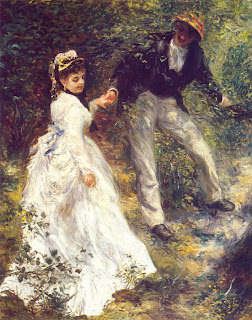
Sunday, October 21, 2007
* World Classic Gallery *

* PIERRE AUGUSTE RENOIR *
BIOGRAPHY and PAINTINGS Renoir, Pierre Auguste 1841 - 1919

Painter, Sculptor, France, Impressionism (style)
Pierre-Auguste Renoir was born in Limoges, France on February 25th, 1841. Renoir's family settles in Paris in 1845 where at the age of 13, he starts painting flowers on China in a porcelain factory. During his spare time, Renoir follows drawing classes and in 1860, he studies in the studio of the Swiss Charles Gleyre where he meets his artist-friends Claude Monet, Alfred Sisley and Frédéric Bazille, the future founders of Impressionism. Around that period, Renoir is also granted permission to copy at the Louvre, where he feels inspired by the 18th century masters such as Boucher, Fragonard and Watteau. In 1862, Renoir is admitted at the Ecole des Beaux-Arts.
In 1867, Renoir’s painting “Lise”, an outdoor painting of his mistress Lise Tréhot, was accepted at the Salon. Two years later Renoir lived with Monet at Bazille’s house. From that period, we have an illustration through Renoir's painting “Frédéric Bazille at his Easel”. His direct influence from Monet made his technique evolve toward little brushstrokes using vibrant colors, leading toward impressionism. Bazille, Monet and Renoir worked closely and shared new techniques, new subjects. Monet and Renoir for instance spent the summer of 1869 at Bougival, an exclusive upper class retreat near Paris, which was famous for its Grenouillère and riverside leisure. The Seine river banks at Asnières, Argenteuil and Chatou with their bath houses, regattas, sailboats and meeting places were to become the favorite setting for the elaboration of their outdoor painting technique and color use. Both painters worked side by side for their own “La Grenouillère”. Though the young artists did have financial problems, they did persist. Renoir writes about him and Monet to his friend Bazille that year: “Although we don’t eat every day, I am still quite cheerful”.
It is in the 1870-ies that Renoir’s technique reaches its peak. Renoir actively participates in impressionnist exhibitions in 1874, 1876, 1877 and 1882 and becomes a founding member of the review “L’Impressionniste” in 1877. From that period, we recall “The Swing” and the “Bal at the Moulin de la Galette”, a great composition gathering numerous friends and Montmartre girls. His technique is now firmy defined; with a masterful rendering of movement and facial expression, Renoir paints youthful portraits of his acquaintances, mostly artists and writers. In his large composition paintings Renoir successfully gathers numerous figures into a singular frame, while capturing the fleeting effect of light and color. Renoir's composition paintings are complex and require many studies; Renoir paintings on the same canvas for weeks to months in a row, changing, adding or removing figures to the setting.
In 1880, Renoir meets Aline Charigot, whom he later marries in 1890. Among other friends, Renoir portraits her in the “Luncheon of the Boating Party” that he executes over several months. It is believed to be a laborous painting both in composition and technique, reacting against his author-friend Emile Zola’s (1840-1902) critique who said about the impressionnists that they sell “sketches that are hardly dry”. With this painting, Renoir captures the specificity of a contemporary moment of 19th century leisure on the Seine, combining still life, portraiture, landscape and genre. This Renoir painting was purchased shortly after by Paul Durand-Ruel, the art dealer who played a key role in promoting his and many young artists’ career. Renoir fully established his reputation with a solo exhibition held at the Durand-Ruel Gallery in Paris in 1883. In 1885, his first son Pierre is born, followed by Jean in 1894 and Claude in 1901. Renoir paintings from the 1880s reflect a steady interest in classical art and the female nude. In 1887, Renoir completes a series of studies of a group of nude female figures known as “The Bathers”. Unsurpassed in the history of modern painting in their representation of feminine grace, these paintings reveal a great ability to depict the soft and pearly texture of skin.
By the 1890s, Renoir and his family begin to spend most of their time away from Paris, in Essoyes and in Cagnes. During the last two decades of his life, Renoir suffers from arthritis. Unable to move his hands freely, a brush would be strapped to his arm to allow him to paint. Renoir's landscape paintings are luminous and vibrate colors, such as in "Terrace at Cagnes, 1905". In 1913, Renoir even begins to work with sculpture. On December 3rd, 1919, Renoir dies at his house in Cagne at the age of seventy eight.

The Luncheon of the Boating Party, 1881, Oil on canvas, 129.5 x 172.7 cm (51 x 68 in.)

Bather with Blonde Hair, 1904-1906, Oil on canvas, 36.22 x 28.74 inches [92 x 73 cm]

Bather with Long Hair, c.1895, Oil on canvas, 32.28 x 25.59 inches [82 x 65 cm]

La Promenade, 1870, Oil on canvas, 31.89 x 25.59 inches [81 x 65 cm]

The Rambler, c.1895, Oil on canvas, 24.21 x 19.69 inches [61.5 x 50 cm]

Two Sisters on the Terrace, 1881, Oil on canvas

Claude Monet Painting in his Garden at Argenteuil, 1875, Oil on canvas, 19.69 x 24.02 inches [50 x 61 cm]

Fruits from the Midi, 1881, Oil on canvas, 19.96 x 25.71 inches [50.7 x 65.3 cm]

Vase of Chrysanthemums, Oil on canvas

Jeanne Samary in a Low-Necked Dress, 1877, Oil on canvas, 22.05 x 18.11 inches [56 x 46 cm]

Study: Torso, Sunlight Effect, c.1876, Oil on canvas, 31.5 x 25.2 inches [80 x 64 cm]

By the Seashore, 1883, Oil on canvas

Girls at the Piano, 1892, Oil on canvas

Yvonne and Christine Lerolle Playing the Piano, 1897, Oil on canvas

Seated Bather, 1893, Oil on canvas

After the Bath, 1888, Oil on canvas

The Bather, 1888, Oil on canvas

The Bathers, 1887, Oil on canvas

Girl with a Hoop, 1885, Oil on canvas

Bouquet, 1885, Oil on canvas
Subscribe to:
Comments (Atom)





.jpg)

















